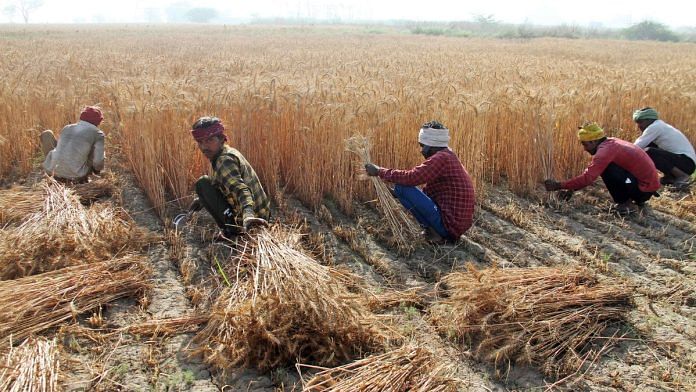Thank you dear subscribers, we are overwhelmed with your response.
Your Turn is a unique section from ThePrint featuring points of view from its subscribers. If you are a subscriber, have a point of view, please send it to us. If not, do subscribe here: https://theprint.in/subscribe/
The next agricultural revolution is already well underway. AgTech researchers, pioneering startups and major agricultural companies are harnessing Industry 4.0 technologies and the latest advances in biotech and genomics to transform the global farming system, which is increasingly under strain, and deliver lasting food security.
Biostimulants are one of the key components of sustainable crop production and are demonstrating an impressive potential to increase crop yields and productivity, develop climate resilience in plants, improve soil health, and contribute to a sustainable farming ecosystem.
The global biostimulant market is expected to reach a value of $5.6 bn by 2033.
What Are Biostimulants?
Unlike fertilizers that are added to the soil to provide crop nutrition, or pesticides that are applied to crops to protect against predation, biostimulants function by stimulating natural processes in plants to enhance their health, resilience and growth.
Biostimulants can be manufactured synthetically or produced from natural microorganisms. They contribute to sustainable agriculture by optimising the natural performance of plants and reducing the need for potentially harmful chemicals throughout the growth cycle.
Research into sustainably sourced biostimulants is yielding a range of interesting and sometimes unlikely materials. These include seaweed extracts, amino acids and peptides, beneficial bacteria and fungi, natural polymers and a variety of humic and fulvic acids. Each material can stimulate a natural function within a plant.
Benefits of Biostimulants
Biostimulants perform a range of different functions in sustainable crop production and treatments can be tailored to crop and soil types and microclimates. Their main roles are to boost nutrient uptake and efficiency, improve plants’ resilience to abiotic stress (e.g., drought, salinity, heat), enhance soil health and microbial activity and stimulate plant metabolism and growth.
Improving Crop Yield and Quality
One of the most urgent requirements for the global agricultural system is to feed a world population that is expected to top 11 billion by the end of the century. By improving crop yields and quality, growers can maximize the productivity of existing farming plots, reducing the need to bring additional land under cultivation.
Biostimulants support better yields in a variety of ways. Corteva Agriscience produces an innovative Utrisha™ N biostimulant that improves crop yields by improving nitrogen use efficiency with an endophytic bacterium Methylobacterium symbioticum. ICL Group’s BIOZ® biostimulants are designed to be integrated into tailored crop nutrient plans and provide solutions for the entire growth cycle, starting with soil health, boosting seed setting, flowering and fruit, and improving stress tolerance and recovery.
When biostimulants are integrated into a detailed crop management plan, they potentially represent a low cost and efficient way to improve crop yields on a natural and sustainable basis. They are not intended as a sole solution for improved crop yields, or as a substitute for fertilizers or pesticides, but as a valuable addition that can reduce dependence on both.
Climate Stress and Resilience
The changing weather patterns and extreme weather events associated with global warming are imposing various stresses on plants. Biostimulants can help to manage stressors like drought, salinity and heat and can also increase resistance to some pests and plant diseases.
One potential advantage that (adaptable) farmers can derive from climate change is that it’s sometimes possible to plant crop types that were previously only viable in more clement locations. Biostimulants are a useful tool for improving the prospects of experimental crops.
Root Development and Soil Health
Plant health and high yields depend on healthy root systems. Data-based use of biostimulants in agriculture can optimize the development of plant roots, including root elongation and the growth of fine root hairs for improved nutrient uptake. Better root systems additionally increase the overall resilience of plants and make them more suitable for transplanting into new plots.
Soil quality is essential for sustainable agriculture and an important benefit of biostimulants is their ability to function as microbial enhancers for a healthier and more diverse soil ecosystem.
Future Outlook
Biostimulants are already making a significant contribution to regenerative and precision agriculture and have a key role to play in the ongoing transition to
sustainable crop production. Analysts have identified the biostimulant industry as a growth market and projected future profits more than justify the investment in R&D that we’re seeing from companies like ICL Group, UPL and Corteva Agriscience.
The future outlook of biostimulants in agriculture – particularly precision and sustainable agriculture – over the next decade looks exceptionally promising.
Written By Jacobo Weizenblut: PhD in Business Management, CEO of Trading ADRs Expert in technology, business & finance, world markets, and energy trends
These pieces are being published as they have been received – they have not been edited/fact-checked by ThePrint.


